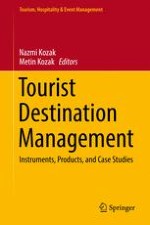
2019 | OriginalPaper | Chapter
1. Social Media Usage Among Top European DMOs
Authors : Ahmet Uşaklı, Burcu Koç, Sevil Sönmez
Published in: Tourist Destination Management
Publisher: Springer International Publishing
Activate our intelligent search to find suitable subject content or patents.
Select sections of text to find matching patents with Artificial Intelligence. powered by
Select sections of text to find additional relevant content using AI-assisted search. powered by